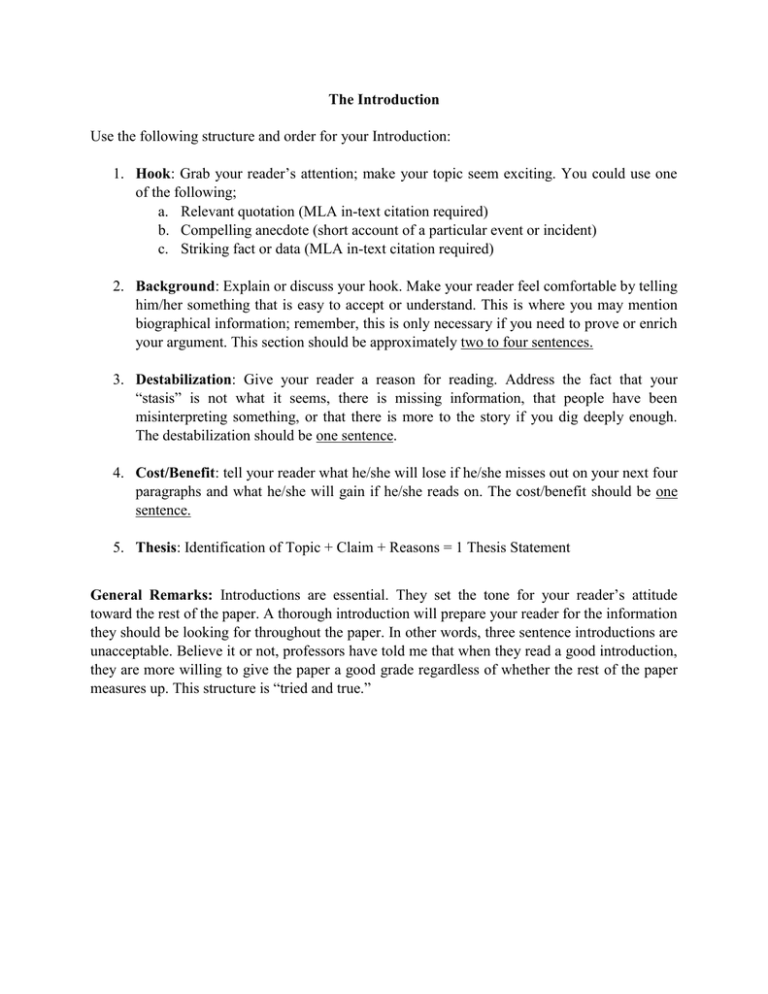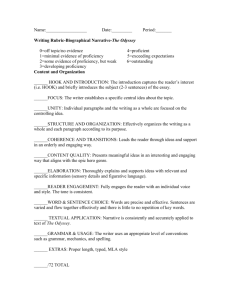Introduction Structure
advertisement

The Introduction Use the following structure and order for your Introduction: 1. Hook: Grab your reader’s attention; make your topic seem exciting. You could use one of the following; a. Relevant quotation (MLA in-text citation required) b. Compelling anecdote (short account of a particular event or incident) c. Striking fact or data (MLA in-text citation required) 2. Background: Explain or discuss your hook. Make your reader feel comfortable by telling him/her something that is easy to accept or understand. This is where you may mention biographical information; remember, this is only necessary if you need to prove or enrich your argument. This section should be approximately two to four sentences. 3. Destabilization: Give your reader a reason for reading. Address the fact that your “stasis” is not what it seems, there is missing information, that people have been misinterpreting something, or that there is more to the story if you dig deeply enough. The destabilization should be one sentence. 4. Cost/Benefit: tell your reader what he/she will lose if he/she misses out on your next four paragraphs and what he/she will gain if he/she reads on. The cost/benefit should be one sentence. 5. Thesis: Identification of Topic + Claim + Reasons = 1 Thesis Statement General Remarks: Introductions are essential. They set the tone for your reader’s attitude toward the rest of the paper. A thorough introduction will prepare your reader for the information they should be looking for throughout the paper. In other words, three sentence introductions are unacceptable. Believe it or not, professors have told me that when they read a good introduction, they are more willing to give the paper a good grade regardless of whether the rest of the paper measures up. This structure is “tried and true.” Harry Potter Ms. Barrett English 11 3 February 2016 The Black Death: A Tragedy Which Ushered Europe into the Renaissance The Black Death struck Europe in approximately 1347, and five years later, twenty-five million people were dead (Dante 214). Never before or again has any plague had such a devastating effect on a population in such a short time. The Black Death’s toll on the population affected both the economy and the people’s undying faith in the church. Once the plague struck, the church and medical world seemed to be helpless in saving the people. The people began to question the authority and beliefs of the church. People began to look for logical reasons and explanations for diseases, thus weakening the basis of everyday life—the church. While the Black Death caused significant strife and struggle, it also inspired new thinking and new learning. No one doubts the immediate effects the plague has on Europe, but few know how the Black Death caused a revolution in the lifestyles and beliefs of the people. The Black Death and the effect it had on the population, the economy, and the religious beliefs of the people enabled Europe to move forward into a more modern society. Bracket [ ] and then label on the right each section of the above introduction.






